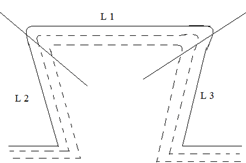This set of Engineering Geology Multiple Choice Questions & Answers (MCQs) focuses on “Classification of Folds – 03”.
1. How many types of folds are there with plunge as a basis?
a) 4
b) 3
c) 2
d) 5
View Answer
Explanation: Only two main types are recognized as the types of folds on the basis plunge.
2. What is a plunging fold?
a) Fold with fold axis horizontal
b) Fold with fold axis only vertical
c) Fold with fold axis not horizontal
d) This is not a type of fold
View Answer
Explanation: Any fold in which fold axis is not horizontal, that is, it makes an angle with the horizontal, may be described as a plunging fold.
3. A fold in which the folding continues in the direction of the axis of the fold is ___________
a) Plunging fold
b) Non-plunging fold
c) Similar fold
d) Doesn’t exist
View Answer
Explanation: Any fold in which the axis of the fold is essentially horizontal, that is, the plunging continues indefinitely in the direction of the axis of the fold is specifically described as non-plunging fold.
4. A fold which is not based on the profile of the folded strata is ___________
a) Cheveron fold
b) Conjugate fold
c) Cuspate fold
d) Plunging fold
View Answer
Explanation: Cheveron fold, conjugate fold, cuspate fold are the types of fold based on the profile of the fold surface whereas, plunging fold is based on plunge of the fold.
5. Folds with two hinges and three planar limbs are called ___________
a) Conjugate folds
b) Cheveron folds
c) Cuspate folds
d) Cylindrical folds
View Answer
Explanation: Conjugate folds are composite folds characterised with two hinges and three planar limbs in which the central limb is exceptionally flattened.
6. Folds characterized by well-defined, sharp hinge points are called ___________
a) Conjugate folds
b) Cheveron folds
c) Cuspate folds
d) Cylindrical folds
View Answer
Explanation: Cheveron folds are the folds characterised with well-defined, sharp hinge points and straight planar limbs.
7. Pick the non-planar fold from the following.
a) Box fold
b) Cheveron fold
c) Conjugate fold
d) Cuspate fold
View Answer
Explanation: The limbs of the cuspate fields are not planar, they are quite clearly curved becoming concave upwards in the case of anticlines and concave downwards in the case of synclines.
8. Which of the following is not true about cylindrical folds?
a) They resemble sections of pipes
b) They have very well defined axes of folds
c) These well defined axes are repeated parallel to each other
d) These well defined axes are not repeated parallel to each other
View Answer
Explanation: Folds in which repetition of axes parallel to themselves is not possible, are classified as non-cylindrical. The first three statements are true about the cylindrical folds.
9. Identify the type of fold shown below.

a) Conjugate fold
b) Cheveron fold
c) Cuspate fold
d) Cylindrical fold
View Answer
Explanation: As we can observe, there are two hinge points and three planar limbs. This is seen in conjugate fold.
10. The hinge joints in cuspate folds are not very sharp.
a) True
b) False
View Answer
Explanation: Cuspate folds are quite clearly curved becoming concave upwards in the case of anticlines and concave downwards in the case of synclines. The hinge zones are, therefore, not very sharp.
11. Folds which mostly occur in groups are based on ___________
a) Profile of the fold surface
b) Mode of occurrence
c) Plunge
d) Relative curvature
View Answer
Explanation: Folds that are based on the mode of occurrence, rarely occur singularly; more often they occur in groups.
12. Which of the following about drag fold is not true?
a) The axes of the drag folds are parallel to those of the major folds
b) The drag folds plunge in the same manner as the major folds
c) The layers on the upper side of the drag folds slide away from the synclinal axis
d) The axes of the drag folds are not parallel to those of the major folds
View Answer
Explanation: It has been established that the drag folds are parallel to those of the major folds. Hence the last option is wrong. The second and the third also true about drag folds.
Sanfoundry Global Education & Learning Series – Engineering Geology.
To practice all areas of Engineering Geology, here is complete set of 1000+ Multiple Choice Questions and Answers.
If you find a mistake in question / option / answer, kindly take a screenshot and email to [email protected]
- Practice Mining Engineering MCQs
- Check Mining Engineering Books
- Check Civil Engineering Books
- Practice Civil Engineering MCQs
- Apply for Mining Engineering Internship
